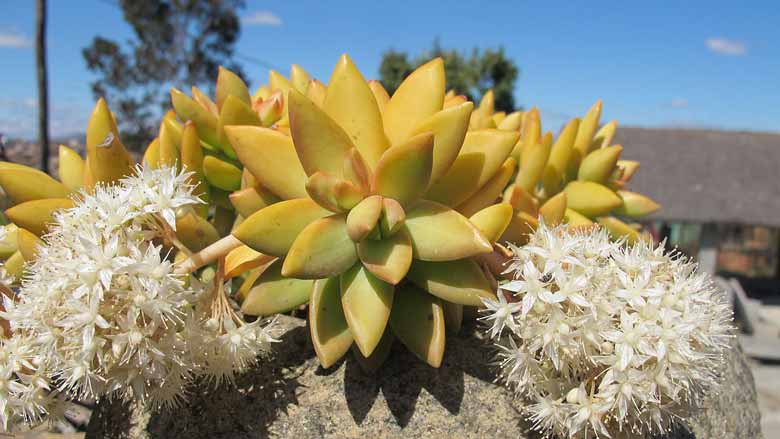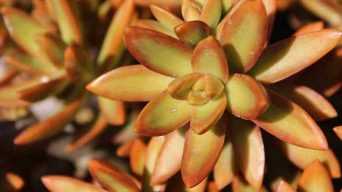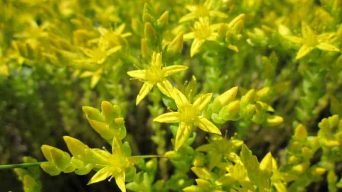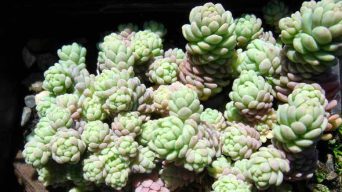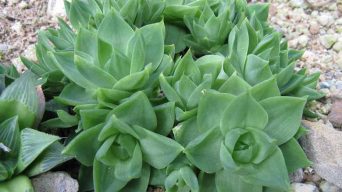This article discusses everything you need to know about Sedum nussbaumerianum care and propagation.
They are easy to care for, making them an ideal choice for those who want a low-maintenance houseplant.
However, while easy to care for and propagate, it’s necessary to know their basic needs so that Sedum nussbaumerianum can grow and thrive.
Overview
The Sedum nussbaumerianum succulent plant is native to Mexico and belongs to the genus Sedum and the family Crassulaceae.
Sedum nussbaumerianum is a succulent plant with many different common names, including the Coppertone Sedum, the Coppertone Stonecrop, Nussbaumer’s Sedums, and Golden Sedum.
This Sedum has plump and long leaves that are yellowish-green in the shade and a beautiful copper color when exposed to direct sunlight.
The Sedum nussbaumerianum can grow between 24 inches (61 cm) and 36 inches (91 cm) long, with rosettes that grow up to 3 inches (7.5 cm).
This Sedum species produces clusters of star-shaped white flowers.
How To Care for Sedum Nussbaumerianum (Coppertone Sedum)
Sedum nussbaumerianum care is not complicated.
It is a matter of following some basic principles that will ensure Sedum nussbaumerianum thrives and grows to its fullest potential.
Sun Exposure & Light Requirements
A Sedum nussbaumerianum succulent plant needs a lot of light.
It should be placed in an area that receives at least six hours of direct sunlight per day, with no obstructions from trees or other plants.
The Coppertone Sedum thrives in full sun to light shade.
It is shade tolerant, but the best coloration and growth occur when it receives full sun.
The Sedum nussbaumerianum succulent plant produces bright orange leaves when exposed to full sun.
This succulent does best when grown outdoors, where it can get at least six hours per day of direct sunlight.
It also thrives well indoors but has better coloration and growth if grown outside.
When exposed to too little light, such as being inside or shaded from trees, this Sedum becomes sparse and thin without any good colors on its leaves.
Watering Requirements
The Sedum Nussbaumerianum should be watered sparingly and not more than once every ten days or when the soil feels dry to the touch in a pot that drains well.
A Sedum nussbaumerianum water needs are much lower than other plants since they have evolved in high altitude desert climates where rainfall is rare.
When watering your Coppertone Sedum succulent, make sure you do so at least 12 inches away from its leaves to prevent it from getting wet and staying moist for too long, which will lead to rot problems.
The most common cause of Sedum nussbaumerianum death is too much water.
If your Sedum succulent starts to look like it’s wilting, you should increase the frequency with which you’re watering.
Above all else, do not overwater!
There are many ways that these plants can become damaged by excess moisture in their soil, such as roots rotting or even root-knot nematodes attacking its base and killing it altogether.
Soil Requirements
The Sedum nussbaumerianum succulent plant is a type of Sedum that needs well-draining soil.
One of the best potting mixes to use with these plants is a cactus or succulents mix.
You can also mix some perlite or vermiculite with the potting soil to ensure that it drains well.
For these plants, a well-draining succulent mix will work best.
The Sedum nussbaumerianum care is simple and straightforward if you use this type of potting mix.
Temperature and Humidity
The Sedum nussbaumerianum succulent plant requires a temperature range of 60 degrees Fahrenheit to 70 degrees Fahrenheit.
This is the same as most other sedums and cacti, but it does not appreciate drafts or cold air coming from outside, so keep that in mind when placing plants outdoors during winter months.
As for humidity requirements, this Sedum prefers 40% – 60% relative humidity. This is the same as most other sedums and cacti, so they like a dry environment.
This succulent does not grow well in high humidity environments because it can lead to problems with insects or fungal diseases being more prevalent.
Fertilizing
Sedum nussbaumerianum succulents do not need to be fertilized very often.
You should only feed your sedum succulents with a weak fertilizer solution (half-strength) and water every few months.
A weak fertilizer solution is typically made by mixing two teaspoons of a liquid, soluble plant food in one quart of water.
Feeding your Sedum succulents every few months in the spring or early summer when they are actively growing.
It’s important to use half-strength liquid fertilizers so as not to burn Sedum leaves.
Remember: never put any fertilizer on sedum plants while wet because this will cause the Sedum’s leaves to rot off!
Potting and Repotting
If you want to pot your Sedum nussbaumerianum, place the plant in a container with drainage holes.
Succulents need well-drained soil, or they will rot and die. The best way to do this is by using cacti/succulent mix (or another succulent-friendly mix).
Fill the bottom of the pot with ¾ inch of pebbles before adding about an inch layer of cactus mix.
Place Sedum on top so that its root ball sits a level above the dirt surface, then fill the remainder up until there are no gaps between Sedum roots and the ground underneath them.
Water thoroughly so all air pockets have been squeezed out entirely from between Sedum roots and dirt.
Potting is best done during spring when sedums are actively growing for maximum success rates – however, it can be done at any point throughout the year if necessary.
Pruning
Sedum Nussbaumererianum plants do not require much maintenance.
The only pruning necessary is for plucking off dead leaves and old flowers, which should be done as soon as you notice them fading or browning.
This will keep your Sedum looking fresh and healthy.
Pests and Diseases
Pests and diseases are not major problems for Sedum nussbaumerianum plants.
They rarely attract pests like slugs, whiteflies, aphids, or mealybugs. If they get infested with these types of insects, it is best to eradicate them before the problem worsens.
You can clean the Sedum with soap and water or plant-safe insecticidal soap.
Likewise, the Sedum nussbaumerianum succulents are not considered to be susceptible to most plant diseases.
However, there is a chance that they may develop root rot if the soil becomes too wet and cold for long periods. This can cause them to fall over or die off altogether.
To prevent this from happening, it is best to ensure that they have plenty of water in the summer and mulch around the plants when temperatures start dropping later in the year.
How to Care for Sedum Nussbaumerianum (Coppertone Sedum) in Winter
Coppertone Sedum winter care is not too difficult, and if you follow the proper steps, it will survive.
Sedum Nussbaumerianum succulents are not cold hardy plants, and exposure to temperatures below 30F can cause damage that may be irreversible.
Extra care is needed in winter, so these sedum plants don’t freeze or dry out.
- Keep Sedums in a bright area with temperatures at 55F or higher.
- If possible, put a light bulb in the room where they are being kept indoors to provide extra warmth.
- Make sure the Sedum is protected from frost, ice, or snow.
- Keep the soil moist but not wet. This will keep it from freezing and breaking apart when frozen and discourage rot during warmer months.
- Coppertone Sedums should be brought inside during severe weather conditions (temps below 30F).
- Keep Sedums out of drafts and from freezing.
- If Sedum nussbaumerianum plants are not brought inside during winter, they will need to be covered with frost cloth.
- A Sedum nussbaumerianum should be moved back outside when the weather starts to warm up.
- They should not stay longer than three months indoors at a time.
If you follow these steps, your Sedum succulent should survive its hibernation through the cold winters!
How To Propagate Sedum Nussbaumerianum (Coppertone Sedum)
Copertone Sedum can be easily propagated from seeds, leaf cuttings, or stem cuttings.
Seeds
To propagate Sedum nussbaumerianum from seeds, simply take a few seeds from an existing Copertone Sedum plant and then sow them in small pots filled with potting soil.
Once they are germinated, move the seedlings to larger containers with more space for growth until the plants reach maturity.
Sedum nussbaumerianum can be grown outdoors if you live in zones nine or higher on an average temperature range of 65-85 degrees Fahrenheit during the day.
Leaf Cuttings
To propagate Sedum nussbaumerianum from a leaf cutting, remove the leaves from an existing plant.
Allow the leaf to callous over for several days and place it on top of potting soil in individual small pots.
Keep these new sedums moist until roots form. Then transfer them to larger containers with more space for growth when they reach maturity.
This type can be grown outdoors if you live in zones nine or higher on an average temperature range of 65-85 degrees Fahrenheit during the day.
If you plan to grow indoors, keep your sedums out of direct bright light because this will cause them to dry up quickly without watering them often enough.
The perfect indoor location is inside a window that receives lots of indirect sunlight but remains shaded by trees, buildings, or other obstructions.
Stem Cuttings
A stem cutting can be taken from sedum nussbaumerianum, which has grown at least six inches tall.
Cut the stem below a leaf node, and then allow this to callous over for several days before planting it in potting soil inside individual small pots.
Keep these new sedums moist until roots form, and transfer them to larger containers with more space for growth when they reach maturity if you live outdoors or indoors, respectively.
Is the Sedum Nussbaumerianum (Coppertone Sedum) Toxic?
The Sedum nussbaumerianum is not toxic to humans or animals.
However, keeping this Sedum away from pets and children is a good idea since they may be tempted to taste one of the leaves.
It would be best to always have gloves when handling sedums to avoid skin irritation from the tiny prickles on their leaves and stems.
Final Thoughts
Sedum nussbaumerianum care is not too difficult to master. It just takes a little patience and time.
It will take you some time to propagate sedum nussbaumerianum, but it is not too difficult of an endeavor.
Once you have successfully propagated Coppertone Sedum, caring for them will be much easier.

